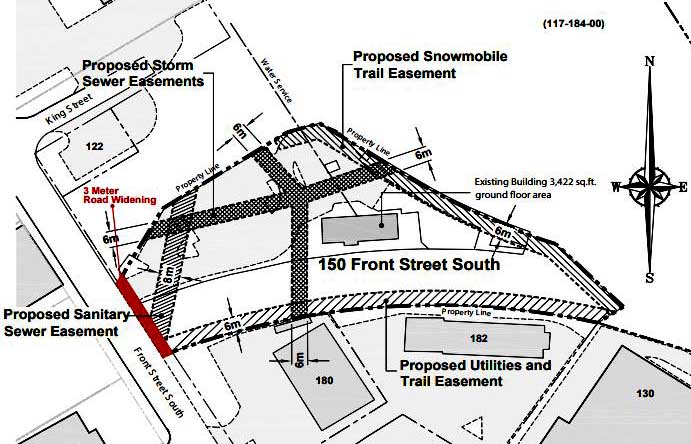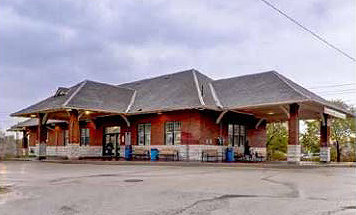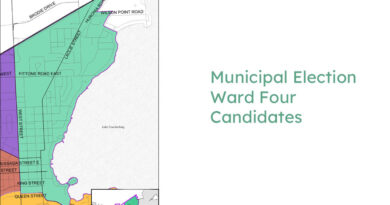Analysis: Anatomy of a Councillor’s Mind
By John Swartz
The old Orillia Train Station on Front Street may have a buyer. Also known as 150 Front Street South, the building housing the chamber of commerce and license bureau has been on the block and off the block several times in the past few years.
The building is 102 years old, built by Grand Trunk Railroad, replacing a rail station which burned down in 1915. Negotiations a little more than a year ago with a buyer fell apart. Council previously designated the building as a heritage property, details of which protect the all aspects of the exterior.
A motion directing staff to negotiate with one potential buyer regarding a proposal received from a listing last fall was passed by a 7 to 2 vote Monday night. This does not mean the property is sold.
Before the vote councillors Jay Fallis and Tim Lauer made arguments to withdraw from negotiations. Lauer asked some interesting questions. He was interested in the timing of the listing, which was for $900,000.
Question Period
“I’m just wondering why there was such a delay between May 2018 and Oct. 26th,” asked Lauer. The property was listed days after the election and a day after he made some inquires about the property with staff.
Gayle Jackson, CAO, said given the history, being listed for sale and then delisted numerous times, they thought the possibility of council being in a lame duck position and unable to proceed with an offer meant waiting until after the election.
“That was resolved at the end of July,” said Lauer. With 7 members of council running when nominations closed it meant at least until election day council would not be in a lame duck position.
“There was a possibility after the election we could be in a lame duck situation” said Jackson.
“Staff did not re-list that property until we were certain,” council would be able to deal with an offer.
Lauer then wanted to know if bidders were aware there was a possibility vehicle access to Front Street could change or be eliminated.
“In past discussion we talked about access along Front Street and what might happen there as traffic counts come in,” said Lauer. He said reconstruction would reduce the number of lanes on Front Street and there was still a possibility any change with King Street might make having driveways to close to the intersection come under scrutiny. This happened before with the Rona (Switzer Timbermart) property which was forced to close Front Street access because of traffic.
“Therefore a proponent who may be bidding on this property could be land-locked. My question is, have all proponents been made aware of that fact,” said Lauer.
“Council has evaluated the sale of this land,” said Jackson. “There was a full package on all the information we had with respect to the property.”
“I’d hate for this to come back to you if this is not known to somebody and it is known to us,” said Lauer.
“If that is in fact an issue and has been identified as an issue it would have been identified in the package,” said Jackson.
A pdf. document of the listing does not mention anything of the nature Lauer spoke of.
“I definitely know I read somewhere there is potential once traffic counts are done on Front Street in front of that property that there is the potential access may not be advisable, or I dreaming that up, or did I read that in a report?” said Lauer.
Wesley Cyr of the City’s development services department said access will be maintained.
Then Lauer wanted to know about a meeting with one proponent; were there other meetings with other potential buyers?
“People who are looking to bid on municipal properties, they certainly can reach out to ask any questions they have. Whether that was the only proponent that actually set up a request for a meeting, I don’t have those particulars in front of me,” said Jackson.
Councillor Ralph Cipolla said he didn’t want to see the building destroyed for development and believed the heritage designation solved that issue.
“Let’s just get on with it. We’ve wasted enough time,” said Cipolla. “We made commitments; let’s live up to our commitments.”
Lauer’s Pitch
When the question was called, Lauer had another turn and used the opportunity to state reasons why he opposed directing staff to negotiate. An abridged version of his entire statement is insightful.
“I’ve got a couple reasons for opposing this.”
“They basically fall into two categories, what I would call practical and the other being more abstract.”
“Under the practical, I have a problem with the idea of selling this property now given what is going on in that area. There’s new development going on in that area. The Schacter lands have just been purchased and there’s going to be some pretty exciting stuff going on there. There’s other developments on Queen Street, the whole area is in transition. I think the value of that property is going to do nothing but increase. The current opinion of value we are using is now is 2 years old, so I’m questioning that.”
“I’m questioning the fact this property was put on the market basically for November, December, January, which are traditionally the slowest real estate months of the year and not when people are really actually thinking about these things.”
“I believe there should have been an RFP process given the importance and the critical location of the property that would be much more appropriate. Once we sell this we have lost control.”
(Zoning permits a variety of commercial retail and light industrial uses, along with a variety of residential uses. Specifically not allowed are any ‘drive-through’ establishments.)
“I believe there’s a lot of easement complexities down there we haven’t necessarily solved and I think it would be to our benefit if we maintain this property until they were. I also think there are potential infrastructure needs in that area which are as yet undefined. We have certainly the potential for a significant storm water facility in that area. The trail system could go through that area.”

“If I look at it for some of the abstract values, the location is critical. It is what’s going to be the gateway to downtown and the waterfront. If you can look ahead and see Front Street developed and King Street moving down into Centennial, as people move into the City from the south and east end, this is going to be where they meet the downtown and where they meet the waterfront. The Downtown Tomorrow plan consistently talked about gateways and creating these spaces and entrance features.”
“The property is perfectly located at the junction of all our major trails. There’s a trail leading to Midland, There’s a trail leading to our rec center, to Georgian College and further to Barrie. Eventually the east trail, hopefully after we get that bridge (over The Narrows) built, will take you around the lake to points east. This building given that location would make an excellent active transit hub, if you are thinking in terms of bike rentals or tourism. I think it could be a significant recreational aspect.”
“If you look at other communities, such as Collingwood, what they’ve done with theirs, and Goderich which actually picked their station up and moved it down to the shore, Barrie’s, Gravenhurst which is still in use as a transportation hub, the potential for that building, in my opinion, certainly outweighs the short term gain that may be realized by selling,”
“I should also point out this is not an all or nothing proposition. We could take the time to try to develop that building and then sever off any land that wasn’t necessary.”
“I think we have got to put the brakes on for a couple years. We need to allow that development to happen in that area. I think we have to get Front Street rebuilt, we need to sort out the King Street extension, we need to sort out our infrastructure needs that might impact that area – the trail, storm water, transit – and while we are waiting we need to explore the cultural and recreational potential of the building; talk to OMAH and possibly the former HCC group.
“The purpose of those talks is to see what is possible, maybe tap into some cultural spaces money. If you are looking for an example of how these things work you need only to look at OMAH. The Sir Sam Steele building was in disarray. There was lots of talk about selling it. Councillors listened to the community. They were very patient. It took years and in the end we have what is probably one of the most vibrant entities in the downtown. This is exactly the same situation.”
“I know there is an embarrassment factor here that some of my colleagues are worried about, as in being a little bit reluctant to take this off the market again, but I think that just cannot be your bottom line reason. The decision not to sell, in my opinion, requires vision and commitment to the best possible results for citizens of Orillia, not the development community.“
“Finally, I think it’s ironic that we are investing millions at the north end of Front Street to undo a development that was wrong in so many ways (70 Front Street North), while perhaps repeating the same mistake a couple blocks south.”
The Insight
The reason SUNonline/Orillia presented almost the entirety of Lauer’s statement is twofold. The inference is the property will bring higher bids in the future when reconstruction is complete and other development is underway. This may be negated by the value to the City for other uses already in motion (e.g. if the City had to buy land in the area for trails, or for storm water management).
It also provides insight into how Lauer thinks regarding many aspects of municipal business. While the group think is usually short term, 4 years, on many issues Lauer frequently brings arguments to the table that are very long range in consequence. Sometimes he is successful in changing the course of action, sometimes, like this, he is not. What is instructive for those who don’t attend council meetings or play the telecast in the background on Monday night’s is the thought process Lauer employs at the council table since he was first elected in 1997.
His arguments have brought this city a tree policy, created importance to the environmental and waste management committees’s work, got Rotary Place fast tracked into existence, and many other things we now take for granted. His newest focus is on storm water management, which during budget he warned will take up more attention by council in the coming years.
What is unique with Lauer is he often ties seemingly disparate functions of municipal life into consideration as no one else is doing, treating council’s decisions with an organic, rather than a compartmentalized perspective.
There have been times he could have said ‘I told you so,’ and time will tell if Lauer is right about the train station property.




